必修一unit2教案
- 格式:doc
- 大小:2.43 MB
- 文档页数:17
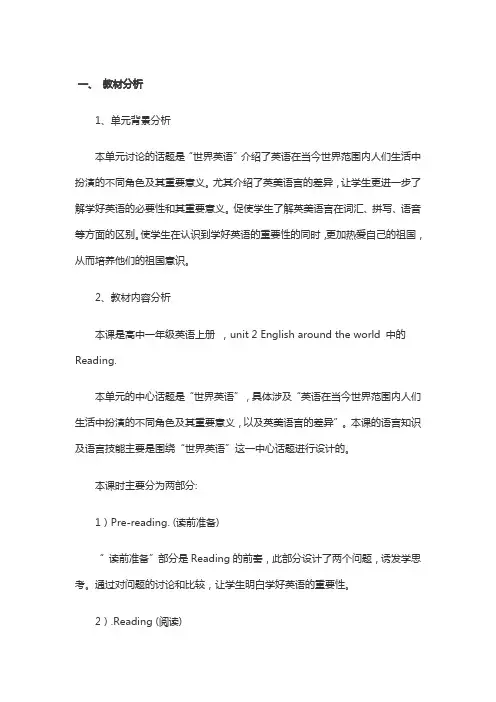
一、教材分析1、单元背景分析本单元讨论的话题是“世界英语”介绍了英语在当今世界范围内人们生活中扮演的不同角色及其重要意义。
尤其介绍了英美语言的差异,让学生更进一步了解学好英语的必要性和其重要意义。
促使学生了解英美语言在词汇、拼写、语音等方面的区别。
使学生在认识到学好英语的重要性的同时,更加热爱自己的祖国,从而培养他们的祖国意识。
2、教材内容分析本课是高中一年级英语上册,unit 2 English around the world 中的Reading.本单元的中心话题是“世界英语”,具体涉及“英语在当今世界范围内人们生活中扮演的不同角色及其重要意义,以及英美语言的差异”。
本课的语言知识及语言技能主要是围绕“世界英语”这一中心话题进行设计的。
本课时主要分为两部分:1)Pre-reading. (读前准备)“读前准备”部分是Reading的前奏,此部分设计了两个问题,诱发学思考。
通过对问题的讨论和比较,让学生明白学好英语的重要性。
2).Reading (阅读)“阅读”部分文体为说明文,全文共分三个段落。
全文阐述了一个鲜明的观点:英语的确是当今世界范围内使用最广泛的一门语言之一,也是联合国的工作语言之一,它的重要作用是其他语言不可替代的。
3)Post-reading(读后)“读后”部分共设计了两类题型:第一部分是和个问题,其中前面两个是细节理解题;第三题是一个开放性题目,鼓励学生把英语学习与现实生活相结合。
第二部分是填空形式,帮助学生梳理文章,掌握文章主要细节,概括中心思想,实为文章的一个纲要。
三部分均以提高学生阅读能力为主,所以将此三部分有科学地整合成一节阅读课。
3、教学重点1)、使学生在认识学好英语的重要性的同时,更加热爱自己的祖国。
2)、发展学生的阅读能力,尤其是归纳总结,猜词和查读(scanning)的能力。
3)、使学生通过交际性任务和合作的机会,培养他们用谚语思维和交际的能力。
4、教学难点1)、使学生在认识到学好英语的重要性的同时,更加热爱自己的祖国,从而培养他们的祖国意识。
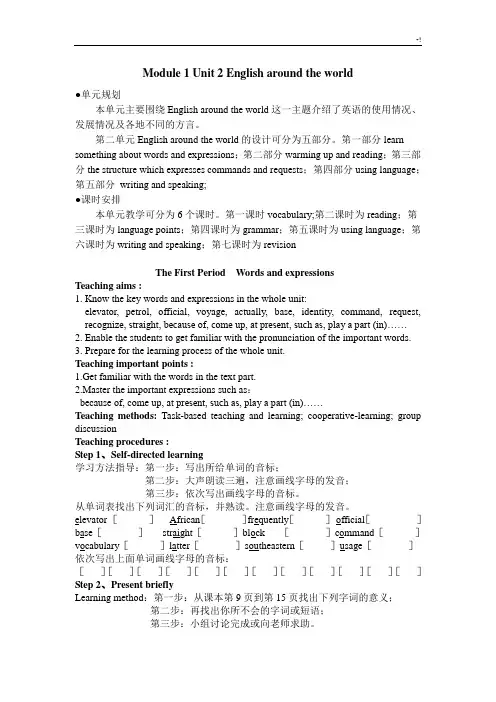
Module 1 Unit 2 English around the world●单元规划本单元主要围绕English around the world这一主题介绍了英语的使用情况、发展情况及各地不同的方言。
第二单元English around the world的设计可分为五部分。
第一部分learn something about words and expressions;第二部分warming up and reading;第三部分the structure which expresses commands and requests;第四部分using language;第五部分writing and speaking;●课时安排本单元教学可分为6个课时。
第一课时vocabulary;第二课时为reading;第三课时为language points;第四课时为grammar;第五课时为using language;第六课时为writing and speaking;第七课时为revisionThe First Period Words and expressionsTeaching aims :1. Know the key words and expressions in the whole unit:elevator, petrol, official, voyage, actually, base, identity, command, request, recognize, straight, because of, come up, at present, such as, play a part (in)……2. Enable the students to get familiar with the pronunciation of the important words.3. Prepare for the learning process of the whole unit.Teaching important points :1.Get familiar with the words in the text part.2.Master the important expressions such as:because of, come up, a t present, such as, play a part (in)……Teaching methods:Task-based teaching and learning; cooperative-learning; group discussionTeaching procedures :Step 1、Self-directed learning学习方法指导:第一步:写出所给单词的音标;第二步:大声朗读三遍,注意画线字母的发音;第三步:依次写出画线字母的音标。
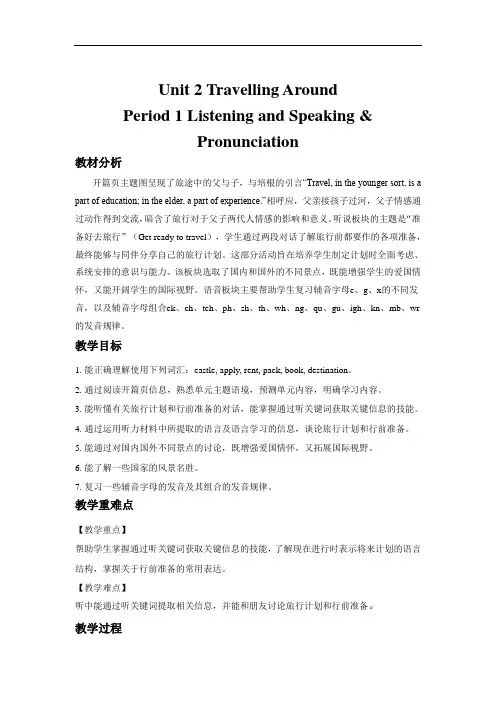
Unit 2 Travelling AroundPeriod 1 Listening and Speaking &Pronunciation教材分析开篇页主题图呈现了旅途中的父与子,与培根的引言“Travel, in the younger sort, is a part of education; in the elder, a part of experience.”相呼应,父亲接孩子过河,父子情感通过动作得到交流,暗含了旅行对于父子两代人情感的影响和意义。
听说板块的主题是“准备好去旅行”(Get ready to travel),学生通过两段对话了解旅行前都要作的各项准备,最终能够与同伴分享自己的旅行计划。
这部分活动旨在培养学生制定计划时全面考虑、系统安排的意识与能力。
该板块选取了国内和国外的不同景点,既能增强学生的爱国情怀,又能开阔学生的国际视野。
语音板块主要帮助学生复习辅音字母c、g、x的不同发音,以及辅音字母组合ck、ch、tch、ph、sh、th、wh、ng、qu、gu、igh、kn、mb、wr 的发音规律。
教学目标1.能正确理解使用下列词汇:castle, apply, rent, pack, book, destination。
2.通过阅读开篇页信息,熟悉单元主题语境,预测单元内容,明确学习内容。
3.能听懂有关旅行计划和行前准备的对话,能掌握通过听关键词获取关键信息的技能。
4.通过运用听力材料中所提取的语言及语言学习的信息,谈论旅行计划和行前准备。
5.能通过对国内国外不同景点的讨论,既增强爱国情怀,又拓展国际视野。
6.能了解一些国家的风景名胜。
7.复习一些辅音字母的发音及其组合的发音规律。
教学重难点【教学重点】帮助学生掌握通过听关键词获取关键信息的技能,了解现在进行时表示将来计划的语言结构,掌握关于行前准备的常用表达。
【教学难点】听中能通过听关键词提取相关信息,并能和朋友讨论旅行计划和行前准备。
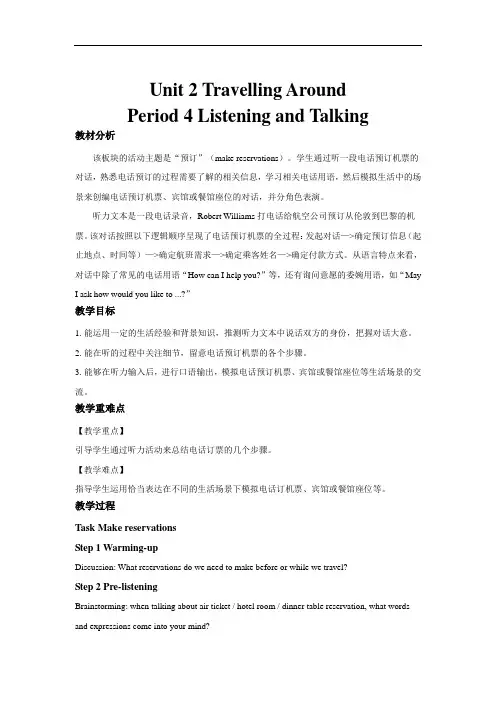
Unit 2 Travelling AroundPeriod 4 Listening and Talking教材分析该板块的活动主题是“预订”(make reservations)。
学生通过听一段电话预订机票的对话,熟悉电话预订的过程需要了解的相关信息,学习相关电话用语,然后模拟生活中的场景来创编电话预订机票、宾馆或餐馆座位的对话,并分角色表演。
听力文本是一段电话录音,Robert Williams打电话给航空公司预订从伦敦到巴黎的机票。
该对话按照以下逻辑顺序呈现了电话预订机票的全过程:发起对话—>确定预订信息(起止地点、时间等)—>确定航班需求—>确定乘客姓名—>确定付款方式。
从语言特点来看,对话中除了常见的电话用语“How can I help you?”等,还有询问意愿的委婉用语,如“May I ask how would you like to ...?”教学目标1.能运用一定的生活经验和背景知识,推测听力文本中说话双方的身份,把握对话大意。
2.能在听的过程中关注细节,留意电话预订机票的各个步骤。
3.能够在听力输入后,进行口语输出,模拟电话预订机票、宾馆或餐馆座位等生活场景的交流。
教学重难点【教学重点】引导学生通过听力活动来总结电话订票的几个步骤。
【教学难点】指导学生运用恰当表达在不同的生活场景下模拟电话订机票、宾馆或餐馆座位等。
教学过程Task Make reservationsStep 1 Warming-upDiscussion: What reservations do we need to make before or while we travel?Step 2 Pre-listeningBrainstorming: when talking about air ticket / hotel room / dinner table reservation, what words and expressions come into your mind?Step 3 While-listening1.Work on Activity 1. Listen to the phone call and answer the questions.(1)What are the two speakers talking about?(2)What is the relationship between the two speakers?2. Listen to conversation again and decide whether the statements are true or false.(1) ( ) The man would like to buy a plane ticket from London to Berlin.(2) ( ) The man prefer the 9:30 flight.(3) ( ) The man would like to travel business class.(4) ( ) The man would like to book a return flight.(5) ( ) The man would like to pay by cash.3. Work on Activity 2. Listen again and complete the table with the words you hear.Step 4 Post-listening1.Please read through the table in Activity 2 and summarize the 5 steps to make a reservation.2.Present some formal and polite expressions used in telephone conversation.Step 5 Pre-talking1.Review words and expressions used in making a reservation.2.Present some useful expressions for booking a hotel room.Step 6 TalkingWork on Activity 3. Imagine you are making plans for the holiday. Choose one of the situations below and role play a phone call with a partner.Step 7 Assignment1.Review words and expressions we learned today.2.Practice making a hotel/flight/dinner table reservation with your family members.高考质量提升是一项系统工程,涉及到多个方面、各个维度,关键是要抓住重点、以点带面、全面突破,收到事半功倍的效果。

人教版高一英语必修一unit2教案高一英语必修一unit2教案1Module 1 Our Body and Healthy Habits1. Lead in.Class, tell me. When you are ill in hospital for a few day,who will pay forit? Your parents? It’s very bad. The health insurance company? Good, it’s muchbetter.Today we are going to learn about the health care system in three differentcountries. Now listen to the tape and try to answer the question:What are the three countries?---Britain, America, and Canada.2. Well, all of you have done a good job. Now read the passage quickly andtry to find the answer to this question:Which health care system do you think is the best? Give two or three sentences to explain why.--I think Canada has a better system, because health care is free. When youbecome ill, medical fees are paid for by the government.3. Answer some more questions:What’s the problem with the American system?The problem is that poorer people don’t have the money to pay for privatehealth insurance. As a result, they often have both health and money problems.Why have there been problems with the British health care system recently?This is because the government has not put enough money into the health service.What’s the result of the problems with the British health care system? More people are using private health insurance. They see doctors and thehealth insurance pay the doctors.4. Deal with some language points:1) pay for sth.pay sbpay money for sthpay sb for sth.pay off the debtspay backpay a visit topay attention to2) begin with= start withThe conference began with a song.高一英语必修一unit2教案2. I wish you were here.wish 后面跟宾语从句,从句中要用虚拟语气,即时态往前推一格, be动词改成过去式时,用 were。
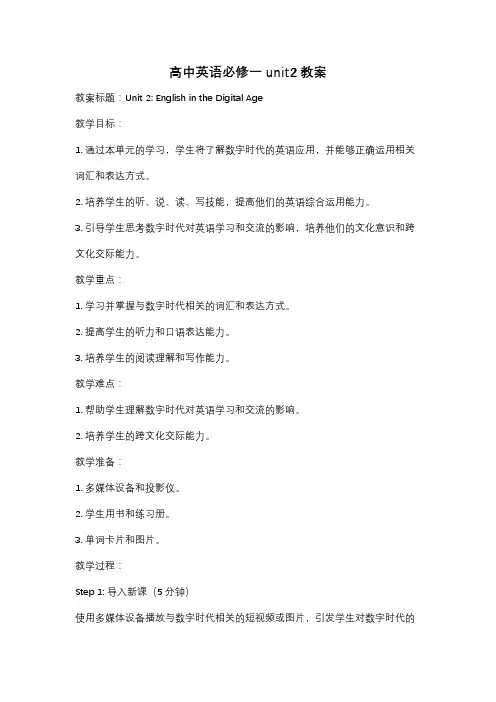
高中英语必修一unit2教案教案标题:Unit 2: English in the Digital Age教学目标:1. 通过本单元的学习,学生将了解数字时代的英语应用,并能够正确运用相关词汇和表达方式。
2. 培养学生的听、说、读、写技能,提高他们的英语综合运用能力。
3. 引导学生思考数字时代对英语学习和交流的影响,培养他们的文化意识和跨文化交际能力。
教学重点:1. 学习并掌握与数字时代相关的词汇和表达方式。
2. 提高学生的听力和口语表达能力。
3. 培养学生的阅读理解和写作能力。
教学难点:1. 帮助学生理解数字时代对英语学习和交流的影响。
2. 培养学生的跨文化交际能力。
教学准备:1. 多媒体设备和投影仪。
2. 学生用书和练习册。
3. 单词卡片和图片。
教学过程:Step 1: 导入新课(5分钟)使用多媒体设备播放与数字时代相关的短视频或图片,引发学生对数字时代的兴趣,并引导他们思考数字时代对英语学习和交流的影响。
Step 2: 学习新词汇(15分钟)教师通过多媒体展示数字时代相关的词汇,并逐一解释其意义和用法。
学生跟读并记忆新词汇,并使用单词卡片进行词汇复习和巩固。
Step 3: 听力训练(20分钟)教师播放与数字时代相关的听力材料,要求学生仔细听取并回答相关问题。
随后,教师与学生一起讨论听力材料中的内容,并帮助学生理解其中的关键信息。
Step 4: 阅读理解(20分钟)学生阅读与数字时代相关的短文或文章,并回答相关问题。
教师可以提供一些问题引导学生思考数字时代对英语学习和交流的影响,并引导学生进行讨论和分享。
Step 5: 口语练习(15分钟)学生分组进行口语练习,讨论数字时代对英语学习和交流的影响。
教师可以提供一些话题和问题,引导学生展开对话,并提供必要的语言支持和指导。
Step 6: 写作训练(20分钟)学生根据所学内容,撰写一篇关于数字时代对英语学习和交流的影响的短文。
教师可以提供写作指导和范文,帮助学生提高写作能力,并对学生的作文进行批改和评价。
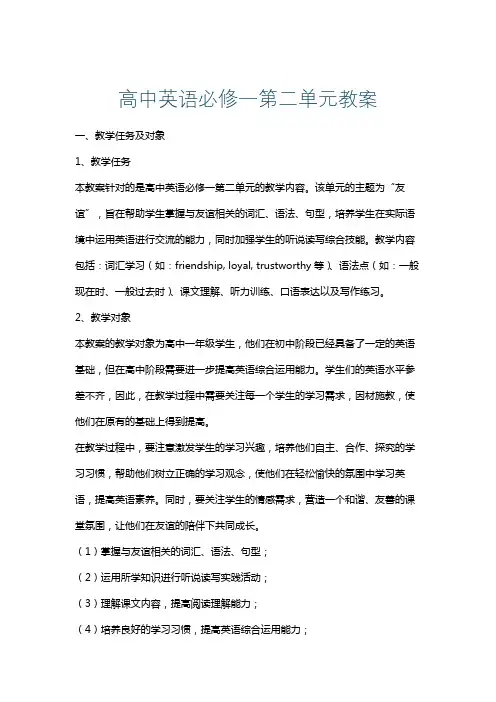
高中英语必修一第二单元教案一、教学任务及对象1、教学任务本教案针对的是高中英语必修一第二单元的教学内容。
该单元的主题为“友谊”,旨在帮助学生掌握与友谊相关的词汇、语法、句型,培养学生在实际语境中运用英语进行交流的能力,同时加强学生的听说读写综合技能。
教学内容包括:词汇学习(如:friendship, loyal, trustworthy等)、语法点(如:一般现在时、一般过去时)、课文理解、听力训练、口语表达以及写作练习。
2、教学对象本教案的教学对象为高中一年级学生,他们在初中阶段已经具备了一定的英语基础,但在高中阶段需要进一步提高英语综合运用能力。
学生们的英语水平参差不齐,因此,在教学过程中需要关注每一个学生的学习需求,因材施教,使他们在原有的基础上得到提高。
在教学过程中,要注意激发学生的学习兴趣,培养他们自主、合作、探究的学习习惯,帮助他们树立正确的学习观念,使他们在轻松愉快的氛围中学习英语,提高英语素养。
同时,要关注学生的情感需求,营造一个和谐、友善的课堂氛围,让他们在友谊的陪伴下共同成长。
(1)掌握与友谊相关的词汇、语法、句型;(2)运用所学知识进行听说读写实践活动;(3)理解课文内容,提高阅读理解能力;(4)培养良好的学习习惯,提高英语综合运用能力;(5)树立正确的友谊观,懂得珍惜友谊。
在此基础上,教师应运用多种教学策略,关注每一个学生的成长,使他们在英语学习中获得全面发展。
二、教学目标1、知识与技能(1)词汇:学生能够掌握本单元的基本词汇,如friendship, loyal, trustworthy, support, communicate等,并能够在实际语境中正确运用。
(2)语法:学生能够理解并掌握一般现在时和一般过去时的用法,能够运用这两个时态进行句子构建和文章写作。
(3)听力:学生能够听懂与友谊相关的对话和短文,提高听力理解能力,并能够抓住关键信息进行答题。
(4)口语:学生能够在日常生活中使用英语进行与友谊话题相关的交流,表达自己的观点和感受,提高口语表达能力。
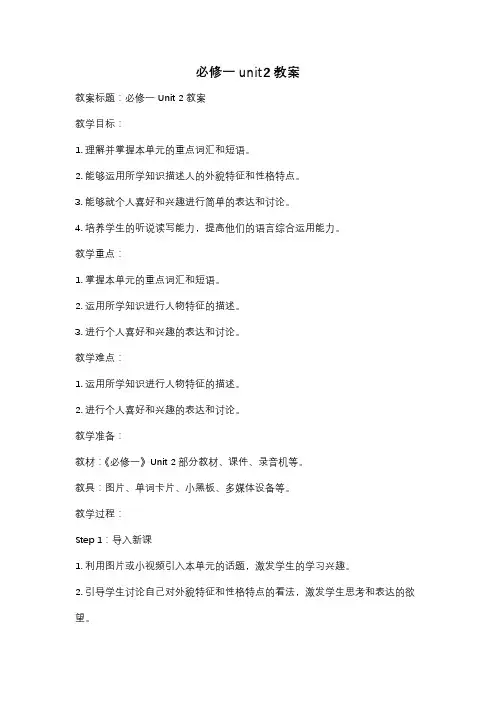
必修一unit2教案教案标题:必修一 Unit 2 教案教学目标:1. 理解并掌握本单元的重点词汇和短语。
2. 能够运用所学知识描述人的外貌特征和性格特点。
3. 能够就个人喜好和兴趣进行简单的表达和讨论。
4. 培养学生的听说读写能力,提高他们的语言综合运用能力。
教学重点:1. 掌握本单元的重点词汇和短语。
2. 运用所学知识进行人物特征的描述。
3. 进行个人喜好和兴趣的表达和讨论。
教学难点:1. 运用所学知识进行人物特征的描述。
2. 进行个人喜好和兴趣的表达和讨论。
教学准备:教材:《必修一》Unit 2 部分教材、课件、录音机等。
教具:图片、单词卡片、小黑板、多媒体设备等。
教学过程:Step 1:导入新课1. 利用图片或小视频引入本单元的话题,激发学生的学习兴趣。
2. 引导学生讨论自己对外貌特征和性格特点的看法,激发学生思考和表达的欲望。
Step 2:词汇和短语学习1. 呈现本单元的重点词汇和短语,通过图片、单词卡片等方式进行学习。
2. 运用多种教学方法,如联想、比较等,帮助学生理解和记忆词汇和短语。
Step 3:听力训练1. 听取本单元的听力材料,帮助学生提高听力理解能力。
2. 组织学生进行听力练习,如听录音并完成相关问题、听录音并填写关键词等。
Step 4:口语训练1. 利用图片或实物,引导学生描述人物的外貌特征和性格特点。
2. 组织学生进行小组活动,就自己喜欢的人物进行描述和讨论。
Step 5:阅读训练1. 进行阅读理解训练,帮助学生提高阅读理解能力。
2. 引导学生进行阅读后的讨论,分享自己的观点和看法。
Step 6:写作训练1. 引导学生进行写作训练,如写一篇关于自己喜欢的人物的短文。
2. 提供写作指导和范文,帮助学生提高写作水平。
Step 7:复习和总结1. 复习本单元的重点词汇和短语。
2. 总结本节课的学习内容,梳理学生的学习成果。
Step 8:作业布置布置相关的练习题或写作任务,巩固所学知识。
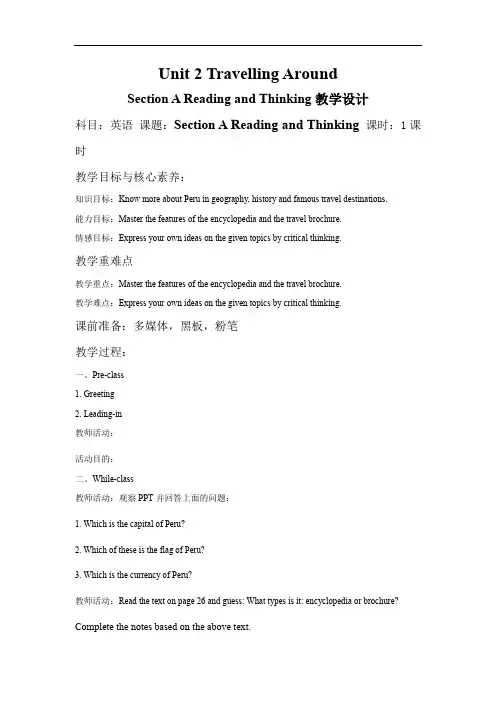
Unit 2 Travelling AroundSection A Reading and Thinking教学设计科目:英语课题:Section A Reading and Thinking课时:1课时教学目标与核心素养:知识目标:Know more about Peru in geography, history and famous travel destinations.能力目标:Master the features of the encyclopedia and the travel brochure.情感目标:Express your own ideas on the given topics by critical thinking.教学重难点教学重点:Master the features of the encyclopedia and the travel brochure.教学难点:Express your own ideas on the given topics by critical thinking.课前准备:多媒体,黑板,粉笔教学过程:一、Pre-class1. Greeting2. Leading-in教师活动:活动目的:二、While-class教师活动:观察PPT并回答上面的问题:1. Which is the capital of Peru?2. Which of these is the flag of Peru?3. Which is the currency of Peru?教师活动:Read the text on page 26 and guess: What types is it: encyclopedia or brochure? Complete the notes based on the above text.Read the and pictures about the text TRA VEL PERU and try to answer the following questions:1. What types is it: encyclopedia or brochure?2. What kind of information does it provide for tourists?答案:1.It is a brochure.2.(1) How to get to the destination.(2) Hotel information.(3) Introduction about tourist attraction and local specialty.3. Read the text and fill in the table. Then discuss the questions below with a partner.Read the text again and decide whether the statements are true (T) or False (F).1. People can explore the rainforest and enjoy some rare and unusual plants and animals in Amazon Rainforest.2. Tourist will drive cars to go through the Andes Mountains on the way to the city of Machu Picchu.3. Inca builders cut stones to exact sizes so that these perfect fit of stones can hold walls together.4. Uros usually use water plants to make their homes.5. In Cusco, people will visit the museums, admire the architecture, stay with a local Uros family, enjoy the excellent local food, and go shopping at the local markets.答案:TFTTFComplete the passage with the correct forms of the new words from the two texts.Cusco is a popoular d_________ for tourists, because of its u_______ place in the history of South America. Cusco was the capital city of the Inca E________ which was the most powerful in South America until the 1500s. There are two especially interesting things to a________ about the Inca civilisation. The first is the roads and p______ they built to connect their important cities. These Inca roads were made up of two north-south highways and many small roads crossing the mountains east to west. The roads were for Inca soldiers and their o________. Second, the Incas built wonderful cities full of amazing architecture—but there were no markets in these cities. One of the interesting questions of history is how the Incas lived without shopping!三、After-classImagine one of you works in a travel agency, please recommend your favorite tour(s) to your customers who would like to travel Peru for their holiday.作业布置:完成同步课时作业。
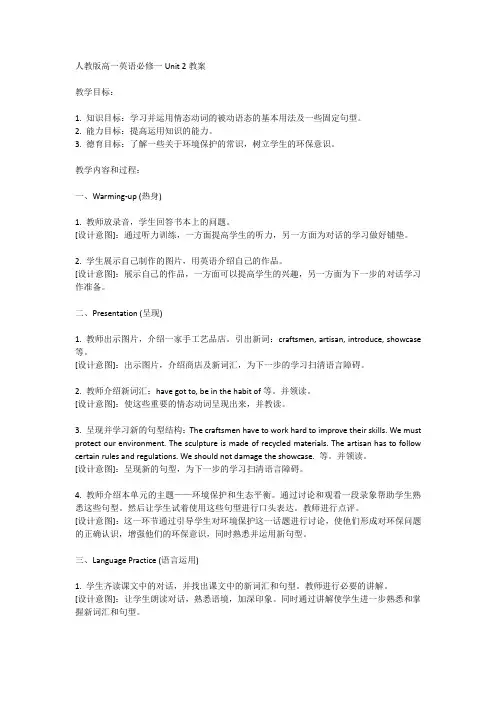
人教版高一英语必修一Unit 2教案教学目标:1. 知识目标:学习并运用情态动词的被动语态的基本用法及一些固定句型。
2. 能力目标:提高运用知识的能力。
3. 德育目标:了解一些关于环境保护的常识,树立学生的环保意识。
教学内容和过程:一、Warming-up (热身)1. 教师放录音,学生回答书本上的问题。
[设计意图]:通过听力训练,一方面提高学生的听力,另一方面为对话的学习做好铺垫。
2. 学生展示自己制作的图片,用英语介绍自己的作品。
[设计意图]:展示自己的作品,一方面可以提高学生的兴趣,另一方面为下一步的对话学习作准备。
二、Presentation (呈现)1. 教师出示图片,介绍一家手工艺品店。
引出新词:craftsmen, artisan, introduce, showcase 等。
[设计意图]:出示图片,介绍商店及新词汇,为下一步的学习扫清语言障碍。
2. 教师介绍新词汇:have got to, be in the habit of等。
并领读。
[设计意图]:使这些重要的情态动词呈现出来,并教读。
3. 呈现并学习新的句型结构:The craftsmen have to work hard to improve their skills. We must protect our environment. The sculpture is made of recycled materials. The artisan has to follow certain rules and regulations. We should not damage the showcase. 等。
并领读。
[设计意图]:呈现新的句型,为下一步的学习扫清语言障碍。
4. 教师介绍本单元的主题——环境保护和生态平衡。
通过讨论和观看一段录象帮助学生熟悉这些句型。
然后让学生试着使用这些句型进行口头表达。
教师进行点评。
[设计意图]:这一环节通过引导学生对环境保护这一话题进行讨论,使他们形成对环保问题的正确认识,增强他们的环保意识,同时熟悉并运用新句型。
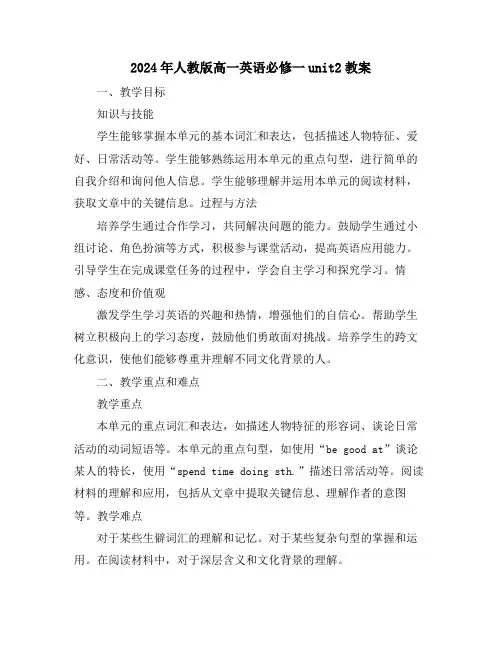
2024年人教版高一英语必修一unit2教案一、教学目标知识与技能学生能够掌握本单元的基本词汇和表达,包括描述人物特征、爱好、日常活动等。
学生能够熟练运用本单元的重点句型,进行简单的自我介绍和询问他人信息。
学生能够理解并运用本单元的阅读材料,获取文章中的关键信息。
过程与方法培养学生通过合作学习,共同解决问题的能力。
鼓励学生通过小组讨论、角色扮演等方式,积极参与课堂活动,提高英语应用能力。
引导学生在完成课堂任务的过程中,学会自主学习和探究学习。
情感、态度和价值观激发学生学习英语的兴趣和热情,增强他们的自信心。
帮助学生树立积极向上的学习态度,鼓励他们勇敢面对挑战。
培养学生的跨文化意识,使他们能够尊重并理解不同文化背景的人。
二、教学重点和难点教学重点本单元的重点词汇和表达,如描述人物特征的形容词、谈论日常活动的动词短语等。
本单元的重点句型,如使用“be good at”谈论某人的特长,使用“spend time doing sth.”描述日常活动等。
阅读材料的理解和应用,包括从文章中提取关键信息、理解作者的意图等。
教学难点对于某些生僻词汇的理解和记忆。
对于某些复杂句型的掌握和运用。
在阅读材料中,对于深层含义和文化背景的理解。
三、教学过程导入新课通过展示一些图片或视频,引导学生讨论图片中的人物特征、活动等,激发他们的兴趣和好奇心。
提出一些与本单元主题相关的问题,让学生思考并回答,为后续的学习做好铺垫。
词汇和句型学习教师呈现本单元的生词和短语,并解释其意义和用法。
通过例句和练习,让学生熟悉并掌握本单元的重点句型。
鼓励学生运用新学的词汇和句型进行自我介绍或描述他人,以检验他们的掌握情况。
阅读理解教师引导学生阅读本单元的阅读材料,并帮助他们理解文章的大意和细节。
通过提问和讨论的方式,让学生分析文章的结构、作者的意图以及文章中的深层含义。
鼓励学生将阅读材料与自己的生活经历联系起来,进行拓展思考和表达。
语法讲解与练习教师对本单元的语法知识进行系统讲解,包括时态、语态、非谓语动词等。
高中英语必修一unit2教案教学设计(一)高中英语必修一 Unit 2 教学设计教学目标•掌握本单元重点词汇和短语的读音、拼写和用法。
•熟练运用本单元的语法知识,能够正确运用一般现在时和一般过去时进行句子构建。
•能够理解并正确运用本单元的重点语言知识和交际用语。
教学重点•重点词汇和短语的掌握和运用。
•一般现在时和一般过去时的句子构建。
•口语和书面表达的实际应用。
教学准备•教科书:必修一 Unit 2•多媒体设备•单词卡片和图片教学过程Step 1:导入新课1.引入新课前,请学生预习相关内容,了解本单元的主题和基本内容。
2.利用多媒体设备播放与主题相关的图片或视频,激发学生的兴趣。
Step 2:语言输入1.根据教材内容,进行重点词汇和短语的讲解,并请学生跟读。
–重点词汇:(列举词汇列表)–重点短语:(列举短语列表)2.通过示范句子,引导学生学习使用一般现在时和一般过去时的句子构建。
–一般现在时:(示例句子)–一般过去时:(示例句子)3.练习语言输入,让学生进行口头对话练习,以巩固新学的词汇和句型。
Step 3:语言输出1.分组活动,让学生根据教材中的对话内容进行角色扮演,模拟真实情境,练习运用所学语言知识。
2.激发学生的创造力,让他们用一般现在时或一般过去时构建有关自己生活经历的句子。
3.学生之间进行交流,分享自己的句子,并互相给予反馈和建议。
Step 4:巩固练习1.在教室内,贴出单词卡片或图片,让学生进行词汇和短语的默写练习。
2.通过听力练习和阅读理解练习,检测学生对本单元语言知识的掌握情况。
3.布置相关练习作为课后作业,以查漏补缺。
Step 5:总结和归纳1.回顾本节课学习的重点和难点内容,做一个简单总结。
2.与学生一起梳理本单元的重点知识和技能,强化学习效果。
教学延伸•鼓励学生多阅读与本单元主题相关的文章或故事,拓宽他们的语言和文化视野。
•提供更多的口语练习机会,如角色扮演、小组讨论、辩论等。
高中英语必修一第二单元教案I. Teaching Objectives1. Knowledge Objectives:- Learn about the history and spread of the English language.- Familiarize students with different varieties of English spoken around the world.2. Ability Objectives:- Develop students' reading and listening skills.- Enhance students' ability to express their opinions and thoughts in English.3. Emotional Objectives:- Cultivate students' curiosity and appreciation for different cultures and languages.- Promote students' awareness of the importance of learning English in a global context.II. Teaching Key Points1. Understanding the history and spread of the English language.2. Recognizing and appreciating different varieties of English spoken around the world.3. Developing reading and listening skills through comprehension activities.III. Teaching Difficulties1. Differentiating between varieties of English and understanding their unique characteristics.2. Encouraging students to actively engage in discussions and express their own opinions.IV. Teaching Methods1. Task-based learning: Engaging students in various activities to promote active learning.2. Audio-visual aids: Using multimedia resources to enhance students' understanding and interest.3. Group work: Encouraging students to work collaboratively and interact with their peers.V. Teaching Aids1. Multimedia resources: Videos, audio clips, and images showcasing different varieties of English.2. Handouts: Reading and listening comprehension exercises.VI. Teaching ProceduresStep 1: Warm-up (15 minutes)- Show a world map on the screen and ask students to identify countries where English is spoken as a first language or is widely used.- Introduce the topic by asking students why they think English is considered a global language.- Facilitate a class discussion by encouraging students to share their thoughts and opinions.Step 2: Pre-reading and Vocabulary (10 minutes)- Introduce key vocabulary words related to the topic, such as "lingua franca," "dialect," and "accent."- Provide definitions and examples for each word.- Ask students to use the words in sentences to ensure understanding.Step 3: Reading Comprehension (20 minutes)- Distribute the reading passage about the history and spread of the English language.- Instruct students to read the passage individually and underline any unfamiliar words.- Discuss the passage as a class, focusing on comprehension questions and addressing any difficulties.- Assign additional comprehension exercises for homework.Step 4: Listening Comprehension (20 minutes)- Play an audio clip showcasing different varieties of English spoken around the world.- Discuss the clip as a class, focusing on unique characteristics and variations in pronunciation and vocabulary.- Have students complete a listening comprehension exercise based on the audio clip.Step 5: Group Work (15 minutes)- Divide students into groups and assign each group a different variety of English to research.- Provide guiding questions to help students gather information about the assigned variety.- Instruct groups to present their findings to the class, highlighting unique features and examples of the variety.Step 6: Class Discussion (15 minutes)- Facilitate a class discussion on the importance of learning different varieties of English in a global context.- Encourage students to share their personal experiences or encounters with non-native English speakers and discuss the challenges and benefits of understanding different accents and dialects.Step 7: Summary and Reflection (10 minutes)- Summarize the key points covered in the lesson.- Ask students to reflect on what they have learned and how it has influenced their perspective on English as a global language.- Provide additional resources or activities for further exploration of the topic outside the classroom.VII. Homework- Assign written reflections on the importance of understanding different varieties of English in a global context.- Encourage students to research and find examples of unique features or characteristics of English spoken in different countries.VIII. Assessment- Evaluate students' comprehension through reading and listening comprehension exercises.- Assess students' participation and contribution during group work and class discussions.- Review students' written reflections on the importance of understanding different varieties of English.。
高一英语必修一unit2教案【5篇】高一英语必修一unit2教案【5篇】高一是同学适应高中英语学习的关键时期,作为一名高一英语老师,你知道如何写一篇英语教案?下面是我为你预备的高一英语必修一unit2教案,快来借鉴一下并自己写一篇与我们共享吧!高一英语必修一unit2教案精选篇5教学目标1. To practise listening comprehension.2.To practise making decisions and reasoning教学重难点1. To practise listening comprehension.2.To practise making decisions and reasoning教学工具课件教学过程Step1. revision1. check the homework exercises.1). It has been reported that children will be offered free education.It has been reported that free education will be offered to children.2). It has been said that we will be offered the latest computer science course book.It has been planned that the latest computer science course book will be offered to us.3). I have been told by Peter that I will be lent his notebook computer for a week.I have been told by Peter that his notebook computer will be lent to me for a week.2. Question: What can computers be used as?Step2. Lead-inAs we know, science and technology is developing very fast and computers have become smaller and smaller. They have been used in many fields. So, the 21st century is the century of information technology What does it mean? Does information technology/ IT only mean things like computers? Of cause not. Actually, it means more than computers. Computers are just one kind of IT. What else do you know is part of IT?(TV, radio, CD-ROM, DVD, books……)Step3. Listening (SB)1. Pre-listening: What are the changes brought by different forms of IT ?What are the advantages and disadvantages of them ?2. While-listening:Go through the chart and make sure the students look at the chart before they listen to the tape. (This is to sharpen their attention and listen for the answers. This will also help them get the gist of the text.) Then Listen to the tape and finish filling in the chart. (If necessary, play the tape for several times.)Say: After listening to their talk, we know all kinds of IT have both disadvantages and advantages.Let’s check the answers together.Type of IT Advantages DisadvantagesTV You can both listen and watch. You cannot write to friends.Web You can find information. It is very expensive.Radio You can listen to English. You cannot watch a film.Book You can get information. Sometimes it is out of date.3. Post-listening:1) (pair work): decide which type of IT is best for you to use right now. Make your choice and give your reasons by using the following expressions.I think that….In my opinion, ….I believe that….I agr ee because….I disagree because….I’ve decided that….2) (group work): Discussion :Computers are useful and have brought us lots of good things, but they also cause bad effects. What attitude should we have towards the computer? (Make good use of it but never get trapped by it.)Step4. Speaking1. Pre-speakingSay: From what we have learn, we should admit that computers and the web have a great influence on the school education as well as people’s life. It has come into people’s everyday life and many families hold computers in their homes. Now there is a task for you.2. While-speaking1) Situation: You have been asked by your parents to help choose computers for your home. You and your friend have looked at several computers. Talk about the special things each computer can do. Make a decision about which kind of computer to buy and explain why.Information input: Show students some pictures of different computers (desktop computer laptop computer …)Language input: Useful expressions (Repeat it to strengthen students’ ability of use it.)Supporting an opinion Challenging an opinionI think that … , because … Perhaps, but what if / about …First, … Have you thought about …One reason is that … What makes you think thatI think it is better because… I don’t like it because….(Pair work )Use the expressions to support your opinion or challenging other’s opinions.2) Oral report: (individual work )Do an oral report to your father and start your report like this: I looked at many different computers. The one I have chosen is the PEP personal computer. One of the main reasons is that it is suitable for homes. I found that…3. Post-speakingConclusion—What useful expression do we use to make a decision and reason?(In this way, they can review and use the words and phrases again.)Step6 Pre-writingSay: Imagine what problems and delights this android might have to deal with while it is serving you. Try yourself in someone else’s shoes is an important way of understanding how other people feel.Then discuss: You are an android. You work for a family with one child who is very spoiled. The parents want you to do everything for them. The parents are nice, but they often ask you to watch over their child. How do you feel? What would you do if the child asked you to do his/her homework for him/her? Would you ever tell the child “no”?Step7 WritingSay: Write a passage about the result of your discussion! It should contain:What do you have to do?What is the child like?What is the parents’ requirement of the child?What do the parents want you to do?What does the child want you to do?Then what will you do? How do you feel?Sample writing:Hello everybody, my name is Liu Yan.I am a 321 model android.I work for the Li family. Mr and Mrs Li work very hard too.Mr Li is an architect and designs great tall apartment blocks.Mrs Li is a doctor and has to look after many patients.I remember all the plans for Mr Lis projects and can tell Mrs Li which drugs are the best to give any particular patient. And I also look after their library. I store all the books that they borrow from their school or friends in my brain.Of course my brain is as large as a mountain, so work like that is no trouble to me.I really eat books just like people eat food.The Lis have a child who is very spoiled. He needs me to remember all his school textbooks so that I can do his homework for him.He just gives me the information on the subject, what has to be done and the page numbers and I get on with it while he enjoys himself with his friends.Sometimes I dont think it is right to do his homework for him — its somewhat cheating. However, his parents are very concerned at the pressure of work in school these days.The child has too much homework to do. They like him to go to the key school but they also want him to be able to have hobbies, learn to swim and keep fit! Poor child!So they consider me the most important person in the family after themselves.I am always introduced to their friends and play with visiting children.I am the perfect family academic aid and, although I was not cheap to buy, Mr Li says I was worth every yuan!Step8 AssessmentGet the students to assess their writing ability according to the following the questions:1. Is your composition well developed?2. Are your ideas well organized to the point?3. Do you have a good choice of words and idioms in your writing?4. Do you get a good mastery of complex structures of language?5. What kind of mistakes have you made in your writing?Step9: HomeworkWrite about your discussion. You may begin like this:Hello, everyone. My name is __X. I’m 321 model android.I work for the Li family….课后小结学了这节课,你有什么收获?课后习题完成课后习题一、二。
Unit 2 Travelling Around-Listening and Speaking &Listening and Talking【教学目标与核心素养】1. Instruct students to get main facts by listening and motivate them to talk about the topics about how to prepare for the trip and make reservations by listening and ultimately can make travel arrangements and reservations.2. Develop students’ sense of cooperative learning and individual thinking capability.3. Develop students’ different listening skills to solve different listening comprehensive problems.4. Help students to understand how to use the structures “the present continuous tense (be doing) is used to express future plans.【教学重难点】1. Teach students how to focus on key words, not on single words or grammar.2. Prompt Ss to talk about the related topics, such as how to prepare for the trip and make a travel plan.【教学过程】Step 1: Listening and SpeakingLead inThe teacher is advised to talk with their students about the places that they want to travel most both at home and abroad: boys and girls, if you have a chance to travel around the world, where will you go? After their small talk, the teacher can move on by finishing the following listening task:Before travelling, what do we need to prepare for the trip?After finishing the task above, the teacher is expected to play Conversation 1 which is about Paul and Meilin’s conversation about coming holiday and after finishing listening for the first time, the students need to solve the following task.1. Circle the two places Meilin is going to for holiday.A. Germany.B. England.C. Iceland.D. France.2. How is she going to get there?A. By sea.B. By air. C .By train.3 How is she planning to get around after she arrives?A .By car. B. By train. C. On foot.After finishing the task above, the teacher is expected to play Conversation 2 which is about where and why Paul is visiting with his family and after finishing listening, the students need to solve the following task.Listen to Conversation 2. Then answer the following questions:1. Where is Paul's family going over the holiday?2. Why are they going there?After finishing the task above, the teacher is expected to play Conversation 3 which contains the whole conversation and solve the following task.Finally, after finishing the task above, the teacher is expected to instruct students to work in groups to finish the following project:Speaking ProjectWork in pairs. Choose a travel destination and discuss how to prepare for the trip.PronunciationHave the Ss listen and repeat. Then try to add more words to each group.Then listen to the sentences below. Let the Ss notice the pronunciation of the letters in bold.Step 2: Listening and TalkingTeacher talks with their students about the related topic: Boys and girls, do you know how to make reservations for a trip? Let’s listen and find out:Play the listening and answer the following questions:1. What are the two speakers talking about?2. What is the relationship between the two speakers?Listen again and complete the table with the words you hear.Making reservationsTalking projectWork in groups.Imagine you are making plans for the holiday. Choose one of the situations below and role-play a phone call with a partner.活动目的:教育学生懂得“水”这一宝贵资源对于我们来说是极为珍贵的,每个人都要保护它,做到节约每一滴水,造福子孙万代。
英语必修一unit2教案教案标题:英语必修一 Unit 2 教案教学目标:1. 通过本单元的学习,学生将能够掌握关于人际交往和情感表达的英语词汇和句型。
2. 学生将能够运用所学知识,描述人物特征、表达情感和进行简单的交流。
3. 学生将培养对他人情感的尊重和理解,提高跨文化交际能力。
教学重点:1. 掌握本单元的重点词汇和短语。
2. 运用所学知识进行人物特征和情感的描述。
3. 学会运用英语进行简单的交流和表达。
教学难点:1. 运用所学知识进行情感表达和人物特征的描述。
2. 提高学生的听说能力,培养他们进行英语交流的自信心。
教学准备:1. 教材:英语必修一(人教版)Unit 22. 多媒体设备3. 教学课件和练习题4. 学生练习册教学过程:Step 1:导入新课(5分钟)1. 利用图片或视频引入新课,激发学生对话题的兴趣。
2. 导入本单元的重点词汇和短语,让学生熟悉相关词汇。
Step 2:课文阅读与理解(15分钟)1. 学生自主阅读课文,了解课文大意。
2. 教师指导学生理解课文中的重点词汇和句型。
3. 进行课文的整体理解和讨论,激发学生对课文内容的思考。
Step 3:词汇与语法讲解(15分钟)1. 教师讲解本单元的重点词汇和短语,并进行相关例句的讲解和练习。
2. 引导学生掌握本单元的语法知识,如形容词的比较级和最高级等。
Step 4:听力训练(15分钟)1. 播放听力材料,让学生进行听力训练。
2. 教师指导学生进行听力答题,并进行听力材料的复述和讨论。
Step 5:口语练习(20分钟)1. 学生进行小组讨论,就本单元的话题展开口语练习。
2. 教师进行适当的指导和纠正,提高学生的口语表达能力。
Step 6:写作训练(15分钟)1. 学生进行写作训练,根据所学知识,描述一个人的外貌和性格特征。
2. 教师进行写作指导和评价,提供学生写作的建议和改进方向。
Step 7:课堂总结与作业布置(5分钟)1. 教师进行课堂总结,复习本节课的重点内容。
高一英语必修一unit2教案教案标题:Activating Prior Knowledge and Vocabulary Building in High School English Class教案主题:Unit 2 - Education (必修一)目标学生:高一学生,学习英语的第一年课时安排:2 课时教学目标:1. 导入前课主题,激活学生的先前知识,引导学生进入本单元主题。
2. 帮助学生学习并巩固本单元相关的词汇,增强学生的词汇能力。
3. 通过小组活动促进学生的互动合作能力和口语表达能力。
教学资源:1. 教材:高中英语必修一(人教版)2. 多媒体工具和投影仪3. 单词卡片、图片、小组分组卡片等课堂活动:课时一:1. 通过问题引入课题(5分钟):- Have you ever thought about how education has evolved over the years? Do you think education is important for everyone? Why?- Can you think of any famous quotes about education? What do they mean to you?2. 激活背景知识(10分钟):- 分组讨论:学生分成小组,利用已学知识,探讨并分享代表不同国家教育系统的现象、优点和缺点。
- 小组展示:代表每个小组的学生分享讨论结果。
3. 导入词汇学习(15分钟):- 使用多媒体工具展示与本单元相关的图片,如学校、教室、教育活动等。
- 给学生提供单词卡片,让他们根据图片猜测相应单词的意思,并找到与之相关的其他单词。
- 学生之间互相交流并共享自己的答案,老师及时纠正并解释生词。
4. 课堂练习(15分钟):- 在黑板上列出一些单词,并要求学生连线匹配单词和对应的中文意思。
- 老师和学生一起检查答案并解释正确答案的含义。
必修一unit2教案第二步:再找出你所不会的字词或短语;第三步:小组讨论完成或向老师求助。
Warming up1.elevator______________2.petrol______________3.official______________4.不止一种____________5.不同于_____________你的生词:_________________ __________________ ________________ Reading1.voyage ___________2.native_________3.apartment________4.actually_________5.base___________6.gradually__________7. Danish___________ 8.vocabulary_________ 9.spelling__________tter___________ 11.identity_________ 12.fluent____________ 13.Singapore________ 14.Malaysia_________ 15.frequently_________ age__________ mand_________ 18.request__________1.因为_____________2.走上前___________3.目前_________________4.利用________________5.例如_________________你的生词:_______________ __________________ _________________Using language1.expression________2.African____________3.Spanish___________4.eastern___________5.southeastern__________6.northwestern_________7.recognize__________8.reward____________9.lorry____________ 10.lightning 11. straight_________ 12.block___________ 13.cab____________1.扮演角色_____________你的生词:_____________ _______________ ______________根据要求,写出下列单词相应的形式。
(3分钟)1)official(adj.) → (n.)办公室→ (n.)政府官员2)gradual(adj.) → (adv.)逐渐地3)latter(adj.) → (adj.)前者、以前的4)fluent(adj.) → (adv.)流利地、流畅地5)frequent(adj.) → (adv.)常常、频繁地6)spelling(adj.) → (v.)拼写7)African(adj.) → (n.)非洲Step 3、Practice1)Wide reading will increase your (词汇量)2)Thecomposition is not well written, and moreover, there are manys mistakes in it.3)I’ve known Betty for years ,since we were babies, (实际上)4) F ,she would find herself looking out of the window, lost in thought.5)People use an e to go up and down stairs.6)He speaks English f .7)He walked along in the shadows, hoping no one would r him.8)I knew from his (口音) that he was from the south.Step 4 Summary and homework1、Write the words and expressions you have learnt during this class.2、Preview warming up and reading part.The Second Period The Road to Modern EnglishTeaching aims :1. Warming-up: Enable students to know the differences between British English and American English.2. Reading:(1)Develop students’ reading abilities and get them to know the development of English language.(2)Talk about difficulties in language communication.Teaching important points :1. To carry out the four reading tasks and get most students understand the passage.2. To give a summary of whole passage.3.To be able to use the different learning strategies for different reading purposes.Teaching methods: Brainstorming, cooperative-learningTeaching procedures :Step 1、Self-directed learningTask:(1) Get the students to discuss in groups about the differences between British English and American English, and give some examples.Method: 小组竞赛,写的最快最多的小组获胜。
(2)Ask students to read passage in warming up and then write the following words词汇美式英式电梯秋天比赛电影糖果Task 1: Fast reading.Let the students read the text as quickly as they can, then decide whether thestatements are true or false:(1)There is no difference between American English and British English. (2)Written English is the same in both American English and British English. (3)Sometimes people from the two countries do have difficulty in understanding each other.(4)The English language in the world always stay the same as the language used in Britain.Task 2 : Careful reading.1. Let the students read the passage carefully and then make a time line of the development of English.2. Let the students read the passage again and fill in the blanks with the words from the text.It is not easy for a Chinese person to speak English as ___ as a ___ English speaker. One reason is that English has a large ___. It also has different usage in different English speaking countries. If you use “flat”instead of “___”, people in America will know you have learned British English. If you use the word “___”instead of “lift” in Britain, people will know you have studied American English.3. Let the students listen to the text carefully and repeat the sentences.Step 3、PracticeLearning methods: 第一步:个人独立完成。
第二步:小组合作核对答案并讨论。
第三步:老师重点讲解。
________All languages change when cultures communicate with one another. The English spoken between AD and 1150 was quitefrom the English spoken today .It’s based more on than the English we speak at present. Later, it became less like German. One big change in English happened when the American Dictionary of the English Language, which gave American English a separate ,came . Now India has a large number of English speakers. This is because English became the language forand education during 1765 to 1947 , when Britain ruled India . English is also spoken in many other countries in Africa and Asia, suchSouth Africa, Singapore and Malaysia. The number of people learning English in China is also increasingStep 4 Group workAsk and answer the questions like these:When did five to seven million people speak English?Why did English begin to be spoken in many other countries?Which country may have the largest number of English learners?Step 5 Summary and homeworkToday we’ve learned an article on “the road to modern English”. After class,you should read it again and again to get the idea of the text further. That’s all for today. Class is over.The Third Period Language pointsTeaching aims :1.Get students to learn useful words and expressions in this part: actually, base, latter, native, because of, come up, at present, make use of, such as, more…than,…2. Enable students to use useful words and expressions correctly.Teaching important points :To master the useful words and expressions;To do exercises with useful words and expressions correctly.Teaching methods: Task-based teaching and learning; cooperative-learning Teaching procedures :Step 1、Self-directed learningTo find the following sentences in the text. (3 minutes to finish)1.以英语作为母语的人,即使他们所讲的语言不尽相同,也可以互相理解。